Actual Ship Equipment
-
- Tug Automation Control System Helps Eliminate False Alarms Maritime Reporter, Nov 2001 #61
When operators of properly equipped tugboats receive a system alarm, they know there is a real problem. They also know that they're not going to get any help from an on-board engineer because the operator is the only one on board.
But Quebec-based Techsol, Inc.'s helps reduce the alarm, thanks to new Marine Automation Control System (MAX) installed in several harbor tugboats designed by Robert Allan Ltd. This state-of-the-art alarm, control, and monitoring system eliminates both false alarms and the need for an on-board engineer, making it possible for only the pilot and shore engineer to handle any problems that might arise.
Techsol. a marine electrotechnology company, created this Unmanned Machinery Space (UMS) system to enable pilots and shore engineers to have a complete picture of a vessel's system via graphical displays and touch screens. Designed to replace existing dedicated systems that were not user friendly, this modular system was built using off-the-shelf equipment from Charlottesville, Va.-based GE Fanuc Automation and adapting it to meet requirements for shipboard systems. GE Fanuc received certification for the components for use in marine applications with the American Bureau of Shipping and Lloyd's Register.
"The main advantages of using standard equipment from GE Fanuc and adapting it to the marine world are twofold: worldwide component availability and lower cost," says Claude Messiaen, Techsol's president and owner. "We're avoiding specialty parts and leveraging proven off-the-shelf hardware.
Techsol chose GE Fanuc's CIMPLICITY human machine interface software and Series 90-30 programmable logic controllers (PLCs) with field I/O modules to create the compact MAX system able to carry out all of the vessel's control, alarm and monitoring functions.
The Series 90-30 field I/O modules are dedicated to specific equipment, and the MAX system requires five or six of these units to achieve complete ship automation.
Because each field I/O module is equipped with a central processing unit (CPU), it can accept input from switches and sensors and generate output to control machines and processes without relying on the processing power of the central PLC. Thus, they can act as standalone devices able to carry out normal functions and keep the machinery operational if the central system fails. Additionally, their autonomous nature provides faster processing and greater reliability.
The modules have the capacity for self-diagnostics down to the sensor level and can generate fault reports on open wire, short circuit, under and over range, and wiring error. These digital and analog modules communicate with up to 700 sensors that monitor operating conditions on the boat's propulsion and auxiliary systems, including main engines, generator and pump control, switchboard logic, fuel transfer, and steering.
When a sensor receives information, such as a fire in the starboard engine, it transfers this information to the fire detection field I/O module. The module then takes immediate tire-suppression steps, sounds an alarm, and also notifies the central PLC of the problem via a high-speed data bus. The Series 90-30 PLC relays this information to the other modules, which take the appropriate self-preservation steps on equipment that they monitor. At the same time, the central PLC converts the information and sends it to the user interface, which shows the operator the type and exact location of the problem. If a field module fails, the central PLC will take over the control for that unit until the fault is cleared, providing a basic level of redundancy at no extra cost.
Opening Windows The CIMPLICITY software receives data from the PLCs and I/O points, acting as a central operator interface for various local and remote controls. This easy-to-use graphical interface was developed on a Windows NT platform, and, in Techsol's applications, is composed of marine-approved computers and touch-screen displays. The software employs an object-oriented approach that makes it simple to create screens to handle any number of operating parameters.
Pre-built and pre-configured screens are readily adapted using graphic tools. A built-in graphics editor incorporates Windows-type toolbars on the development screen. The user simply selects a tool for drawing, or for adding text and button objects. An Object Linking and Embedding (OLE) button eases importation of OLE 2.0 objects such as spread sheets, charts, and bitmapped images. Once objects are created, they can be resized, rotated or moved using the "handles" that appear when the object is selected. Additionally, operators are able to switch CIMPLICITY screens in less than half a second, ensuring accurate data and quick response.
Since CIMPLICITY was developed under Windows NT, it interfaces easily with any third-party equipment, and screens can be easily adapted to reflect replaced or upgraded equipment.
Techsol took advantage of the software's open architecture by creating AutoCAD drawings of the engine and importing them into CIMPLICITY.
Since the screens were developed using actual ship equipment, what the operator sees on screen accurately depicts the equipment and its exact location on board. MAX has 13 to 20 different screens, and most equipment graphics displayed on the screens relate detailed information in response to a touch by the operator's finger. This configuration gives the operator easy comprehension of the system layout without any specific or advanced technical knowledge, which is a key benefit of the Techsol system.
One company that has seen this benefit firsthand is Robert Allan Ltd., Canada's oldest privately owned consulting naval architectural firm, providing marine consulting and design services to a worldwide client base. Headquartered in Vancouver, the company specializes in tug and barge transportation, shipassist and escort tugs, and fast patrol craft "Our principal products as naval architects are high-performance tugs with very low levels of manning." says Robert Allan, president and owner of Robert Allan Ltd. "A very high standard of automation is required, and that really implies a system like the one Techsol is producing," CIMPLICITY's high standard of automation allows MAX to be controlled by only one on-board operator, and its flexibility permitted Techsol to design a system that generates no false alarms. That's 110 easy feat by marineworld standards.
Techsol created custom scripts, or algorithms, for MAX. By following these algorithms, the system reacts to varying conditions and eliminates possible false alarms. For example, when a tugboat maneuvers, fuel has a tendency to slosh around in the tank, generating low-fuel alarms. With MAX, when the pilot maneuvers the boat, input from the joystick automatically disables the fuel tank low-level alarm, so sloshes will not cause alarms.
According to Messiaen. U.S. Navy representatives recently experienced a trial run and demonstration of a tugboat equipped with MAX. and were impressed when the system did not give any false alarms. Civilian watercraft makers are also impressed with MAX.
as well as makers of luxury yachts and large offshore tugs. Techsol is also working with a U.S. engine maker to specify MAX as the standard control system for their engines.
Techsol installs MAX in new construction as well as retrofits, and the team has found that the system merges easily with existing equipment. So easily.
in fact, that Techsol retrofitted a control system on a 400-car ferry over a five-week period without ever having to take the vessel out of service.
"When we do retrofits, we try to save what we can," Messiaen says. "We use MAX with the existing equipment, especially sensors, and the modules from GE Fanuc are wonderful at integrating with the on-board architecture." In the future. Techsol looks to integrate the CIMPLICITY software with a predictive maintenance package. By incorporating predictive maintenance into their system. Techsol will be able to expand MAX's capabilities, enabling it to automatically inform the operator when preventive and regularly scheduled maintenance should be performed.
Not only will the new system eliminate false alarms, it will help prevent true alarms from happening with preventive maintenance. Now that's keeping a ship afloat.
Circle 11 on Reader Service Card
-
 )
March 2024 - Marine Technology Reporter page: 45
)
March 2024 - Marine Technology Reporter page: 45ronments. The new agreement will address speci? c techni- cal gaps in the UUV defense and offshore energy markets especially for long duration, multi-payload mission opera- tions where communications are often denied or restricted. As part of the new alliance, Metron’s Resilient Mission Autonomy portfolio
-
 )
March 2024 - Marine Technology Reporter page: 42
)
March 2024 - Marine Technology Reporter page: 42NEW TECH OCEANOLOGY INTERNATIONAL 2024 Image courtesy Greg Trauthwein Image courtesy BIRNS MacArtney launches the new ultra-compact ø12.7 mm SubConn Nano connector. Innovative connectivity built on 45 years of ? eld-proven and market-trusted design. Image courtesy MacArtney Birns celebrated its 70th
-
 )
March 2024 - Marine Technology Reporter page: 38
)
March 2024 - Marine Technology Reporter page: 38batteries. The NiCad The best way to determine a battery’s capacity is to measure battery can handle very high discharge rates, on the order of its actual performance using a computer-controlled battery ana- 15C, with no damage or loss of capacity. lyzer, such as the Computerized Battery Analyzer (CBA
-
 )
March 2024 - Marine Technology Reporter page: 36
)
March 2024 - Marine Technology Reporter page: 36LANDER LAB #10 Of special interest for marine applications, LiPo batteries are Shipping any kind of lithium battery can be a challenge, and offered in a “pouch” design, with a soft, ? at body. The pouch IATA regs vary with the batteries inside or outside an instru- is vacuum-sealed, with all voids ?
-
 )
March 2024 - Marine Technology Reporter page: 34
)
March 2024 - Marine Technology Reporter page: 34its Batteries are assigned a capacity rating based on some mod- ability to discharge current over a period of time, measured erate Discharge Rate. If the actual rate exceeds that moderate in amp-hours. A battery’s energy, measured in watt-hours, is discharge rate, the battery will be depleted faster due to
-
 )
March 2024 - Marine Technology Reporter page: 25
)
March 2024 - Marine Technology Reporter page: 25Auerbach explained that ideally, “one ? ed layers of geothermal activity,” noted changes over an area of 8,000 km2. They would have both instruments: seismom- Skett, “and the change in salinity and dis- found up to seven km3 of displaced ma- eters to detect and locate subsurface ac- solved particles for
-
 )
March 2024 - Marine Technology Reporter page: 11
)
March 2024 - Marine Technology Reporter page: 11assist in identifying mines and act as a neutralization device. About the Author Bottom mines pose even greater chal- David R. Strachan is a defense analyst and founder of lenges. Unlike contact mines, bottom Strikepod Systems, a research and strategic advisory mines utilize a range of sensors to
-
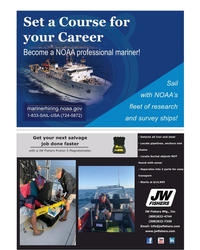 )
March 2024 - Marine Technology Reporter page: 7
)
March 2024 - Marine Technology Reporter page: 7Set a Course for your Career Become a NOAA professional mariner! Sail with NOAA’s fleet of research marinerhiring.noaa.gov 1-833-SAIL-USA (724-5872) and survey ships! - Detects all iron and steel Get your next salvage - Locate pipelines, anchors and job done faster chains with a JW Fishers
-
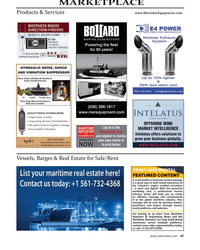 )
April 2024 - Maritime Reporter and Engineering News page: 47
)
April 2024 - Maritime Reporter and Engineering News page: 47MARKETPLACE Products & Services www.MaritimeEquipment.com Powering the fleet for 60 years! HYDRAULIC NOISE, SHOCK AND VIBRATION SUPPRESSOR Noise, Shock, VibraO on & PulsaO on in Quiet, Smooth Flow Out Oil Bladder Nitrogen (blue) Manufactured by MER
-
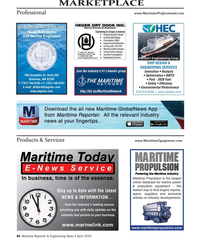 )
April 2024 - Maritime Reporter and Engineering News page: 46
)
April 2024 - Maritime Reporter and Engineering News page: 46MARKETPLACE Professional www.MaritimeProfessional.com GILBERT ASSOCIATES, INC.GILBERT ASSOCIATES, INC. Naval Architects and Marine Engineers SHIP DESIGN & ENGINEERING SERVICES Join the industry’s #1 Linkedin group )NNOVATION
-
 )
April 2024 - Maritime Reporter and Engineering News page: 43
)
April 2024 - Maritime Reporter and Engineering News page: 43“The industry is an ecosystem which includes owners, managers, mariners, shipyards, equipment makers, designers, research institutes and class societies: all of them are crucial,” – Eero Lehtovaara, Head of Regulatory & Public Affairs, ABB Marine & Ports All images courtesy ABB Marine and Ports provi
-
 )
April 2024 - Maritime Reporter and Engineering News page: 42
)
April 2024 - Maritime Reporter and Engineering News page: 42OPINION: The Final Word Seeing the Ship as a System Shipping must engage with the decarbonization realities that lie ahead by changing the way it crafts maritime legislation to re? ect its place in the interconnected, interdependent world economy, said Eero Lehtovaara, ABB Marine & Ports. ABB Marine &
-
 )
April 2024 - Maritime Reporter and Engineering News page: 41
)
April 2024 - Maritime Reporter and Engineering News page: 41Nautel provides innovative, industry-leading solutions speci? cally designed for use in harsh maritime environments: • GMDSS/NAVTEX/NAVDAT coastal surveillance and transmission systems • Offshore NDB non-directional radio beacon systems for oil platform, support vessel & wind farm applications
-
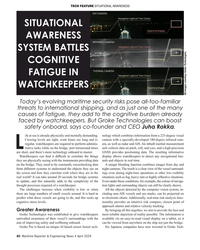 )
April 2024 - Maritime Reporter and Engineering News page: 40
)
April 2024 - Maritime Reporter and Engineering News page: 40TECH FEATURE SITUATIONAL AWARENESS SITUATIONAL AWARENESS SYSTEM BATTLES COGNITIVE FATIGUE IN WATCHKEEPERS All images courtesy Groke Technologies Today’s evolving maritime security risks pose all-too-familiar threats to international shipping, and as just one of the many causes of fatigue, they add
-
 )
April 2024 - Maritime Reporter and Engineering News page: 39
)
April 2024 - Maritime Reporter and Engineering News page: 39Tech Files Latest Products, Systems and Ship Designs “Wall Climbing Robot” Danish Pilot calls gets ClassNK Nod LEGO Model "A tribute build to a work life at sea" Image courtesy MOL, Sumitomo Heavy Industries lassNK granted its Innovation Endorse- Image courtesy Espen Andersen/DanPilot ment for
-
 )
April 2024 - Maritime Reporter and Engineering News page: 38
)
April 2024 - Maritime Reporter and Engineering News page: 38Tech Files Latest Products, Systems and Ship Designs Zero-Emission Mooring Service of a Tanker Consulmar achieved a milestone by executing what it calls ing boat Castalia, which operates on full electric propulsion. the world's ? rst zero-emissions mooring service for a tanker. Equipped with two 150 kW
-
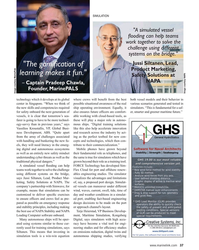 )
April 2024 - Maritime Reporter and Engineering News page: 37
)
April 2024 - Maritime Reporter and Engineering News page: 37SIMULATION "A simulated vessel ? ooding can help teams work together to solve the challenge using different systems on the bridge." – Jussi Siltanen, Lead, "The gami? cation of Product Marketing, learning makes it fun." Safety Solutions at NAPA – Captain Pradeep Chawla, Founder, MarinePALS Image
-
 )
April 2024 - Maritime Reporter and Engineering News page: 35
)
April 2024 - Maritime Reporter and Engineering News page: 35SIMULATION e have a close relationship with tech- Realism is prized beyond immersive, photo-realistic visu- nology, evidenced by, for example, als, and providers are introducing increasingly accurate func- the phones we are estimated to un- tionality. FORCE Technology’s upcoming DEN-Mark2 math- lock around
-
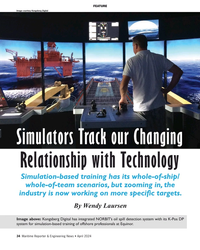 )
April 2024 - Maritime Reporter and Engineering News page: 34
)
April 2024 - Maritime Reporter and Engineering News page: 34FEATURE Image courtesy Kongsberg Digital Simulators Track our Changing Relationship with Technology Simulation-based training has its whole-of-ship/ whole-of-team scenarios, but zooming in, the industry is now working on more speci? c targets. By Wendy Laursen Image above: Kongsberg Digital has integrated
-
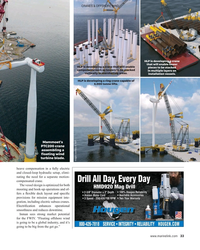 )
April 2024 - Maritime Reporter and Engineering News page: 33
)
April 2024 - Maritime Reporter and Engineering News page: 33CRANES & OFFSHORE WIND HLP is developing a crane that will enable tower HLP is developing a crane that will enable pieces to be stacked components such as towers to be stacked in multiple layers on vertically in marshalling areas. installation vessels. HLP is developing a ring crane capable of 6
-
 )
April 2024 - Maritime Reporter and Engineering News page: 29
)
April 2024 - Maritime Reporter and Engineering News page: 29RADM PHILIP SOBECK, MILITARY SEALIFT COMMAND U.S. Navy photo by Bill Mesta/released U.S. Navy photo by Ryan Carter Rear Adm. Philip Sobeck, Commander, United States Navy’s Military Sealift Command, visits USNS Patuxent (T-AO 201) for a tour of the ship at Naval Station Norfolk, Va., November 20, 2023.
-
 )
April 2024 - Maritime Reporter and Engineering News page: 28
)
April 2024 - Maritime Reporter and Engineering News page: 28FEATURE INTERVIEW track missiles and warheads for the Mis- sile Defense Agency, and it travels with its support ship, the MV Hercules. For our Service Support ships, we have the two hospital ships, USNS Mer- cy and Comfort; two rescue and salvage ships; two submarine tenders; and the Sixth Fleet ?
-
 )
April 2024 - Maritime Reporter and Engineering News page: 27
)
April 2024 - Maritime Reporter and Engineering News page: 27RADM PHILIP SOBECK, MILITARY SEALIFT COMMAND With COVID, we had to make some hard choices for our Do your CIVMARs have upward mobility? mariners because we couldn’t rotate. Many of our mariners The Navy has Sailors who become “Mustangs,” and work found other employment, and were able to use their skills
-
 )
April 2024 - Maritime Reporter and Engineering News page: 26
)
April 2024 - Maritime Reporter and Engineering News page: 26FEATURE INTERVIEW “Over the next decade, 12 new classes of ships will come online and MSC will see up to 20 new ships deliver to the ? eet in the next ? ve years. This includes new oilers, towing, salvage and rescue tugs, and expeditionary fast transports and emergency medical ships. A large
